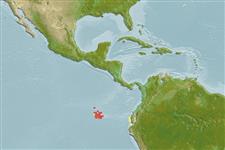>
Blenniiformes (Blennies) >
Chaenopsidae (Pike-, tube- and flagblennies)
Etymology: Acanthemblemaria: Greek, akantha = thorn + Greek, emblema, -atos, anything that is nailed, knocked in; also anything with bass or high relief (Ref. 45335).
Eponymy: Miguel Castro was an Ecuadorian naturalist resident on the Galapagos Islands. He became (1960) the first conservation officer at the Charles Darwin Research Station, Academy Bay, Santa Cruz Island, Galapagos. (Ref. 128868), visit book page.
Environment: milieu / climate zone / نطاق العمق / distribution range
البيئة
بحري مرتبطة بالشعاب; نطاق العمق 1 - 23 m (Ref. 5227), usually 6 - 12 m (Ref. 5227). Tropical
Southeast Pacific: endemic to the Galapagos Islands.
الحجم / وزن / العمر
النضج: Lm ? range ? - ? cm
Max length : 6.0 cm TL ذكر/ مختلط الجنس; (Ref. 11482)
Lives in empty barnacle shells. Often perches in the opening with only the head protruding. Seldom seen in the open. Darts out to nab bits of floating food (Ref. 5227). Oviparous (Ref. 56066). Eggs are attached to the walls of the parent's shelter and are brooded by the male parent (Ref. 56066).
Life cycle and mating behavior
النضج | التكاثر | وضع البيض | بيض | الخصوبة | Larvae
Oviparous (Ref. 56066). Males guard the eggs until they hatch (Ref. 56066).
Allen, G.R. and D.R. Robertson, 1994. Fishes of the tropical eastern Pacific. University of Hawaii Press, Honolulu. 332 p. (Ref. 11482)
IUCN Red List Status (Ref. 130435: Version 2025-1)
استخدامات بشرية
أدوات
تقارير خاصة
Download XML
مصادر علي الأنترنت
Estimates based on models
Preferred temperature (مرجع
123201): 23.5 - 25.6, mean 23.8 °C (based on 20 cells).
Phylogenetic diversity index (مرجع
82804): PD
50 = 0.5000 [Uniqueness, from 0.5 = low to 2.0 = high].
Bayesian length-weight: a=0.00525 (0.00219 - 0.01260), b=3.06 (2.85 - 3.27), in cm total length, based on LWR estimates for this (Sub)family-body shape (Ref.
93245).
مستوى غذائي (مرجع
69278): 3.4 ±0.5 se; based on size and trophs of closest relatives
Fishing Vulnerability (Ref.
59153): Low vulnerability (10 of 100).
🛈
Nutrients (Ref.
124155): Calcium = 172 [84, 323] mg/100g; Iron = 0.903 [0.516, 1.590] mg/100g; Protein = 18 [17, 19] %; Omega3 = 0.105 [0.054, 0.200] g/100g; Selenium = 19.9 [8.7, 46.4] μg/100g; VitaminA = 337 [106, 1,109] μg/100g; Zinc = 2.18 [1.38, 3.25] mg/100g (wet weight);
